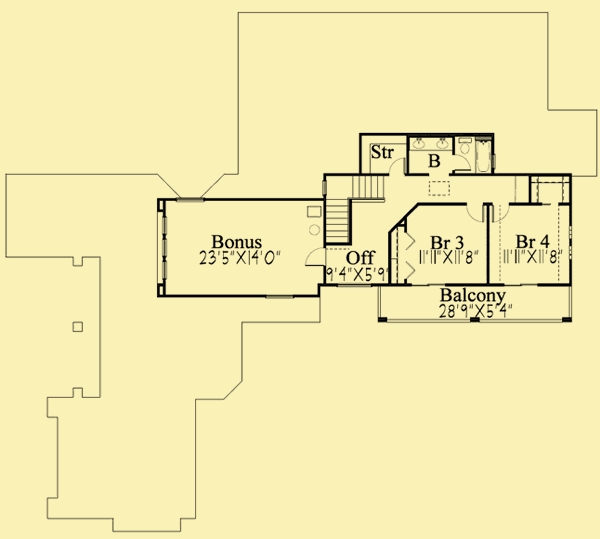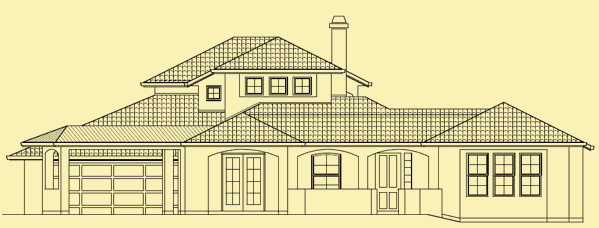Main Level Floor Plans For Mission Style With Courtyard

Upper Level Floor Plans For Mission Style With Courtyard


| Total Above-ground living area | 3026 |
| Main | 2317 |
| Upper | 709 |
| Lower level living area | |
| Footprint The dimensions shown are for the house only (indicating the smallest area needed to build). They do not include the garage, porches, or decks, unless they are an integral part of the design. |
62.667 W x 87.75 D |
| Above-ground bedrooms | 4 |
| Above-ground bathrooms | 3 |
| Master suite | Main |
| Lower-level bedrooms | 0 |
| Lower-level bathrooms | 0 |
| Stories | 2 |
| Parking | garage |
| Number of stalls | 3 |
| House height
Traditionally, the overall height of a house is determined by measuring from the top of the finished floor on the main level, to the highest peak of the roof.
|
24 |
| Ceiling heights Raising or lowering the height of the ceilings on one or more floors of a house is often a simple change that can be made by your builder. However, if you want to raise the ceiling of the main floor of a two-story home, there has to be room to add steps to the existing staircase. |
|
| Main level | 10 |
| Upper level | 9 |
| Vaulted ceilings
We consider a room to be vaulted if the ceiling - whether flat, angled, or curved - is above 10 feet at its highest point. If you prefer that one or more rooms not be vaulted in your new home, this is a very simple change that your builder can make for you.
KEY TO SYMBOLS: LR = Living Room/Great Room DR = Dining Room FAM = Family Room FOY = Foyer STU = Study/Library/Den KIT = Kitchen SUN = Sunroom MBR = Master Bedroom MB = Master Bath LOF = Loft OFF = Office/Guest Room REC = Recreation/Game Room ALL = Entire Level |
LR |



The first thing that catches your eye as you approach this striking home is the roof, with its undulating pattern and texture, and soft, muted colors. The exterior walls have a thick coating of stucco, and brick veneer wraps around the columns and arches. There’s a lovely 20′ by 20′ courtyard at the front, and a porte cochere on the left side of the house that you pass through on the way to the 3–car garage. And on the inside, angled walls create atypical living spaces that are uniquely beautiful and fully functional.
The courtyard is formed by a graceful low wall at the front, and projecting portions of the house on either side. As you enter the house and step into the foyer, you can either turn right and step down two stairs to enter the sunken great room; turn left to enter a family gathering spot and the kitchen beyond it; or go straight ahead through a pair of etched–glass doors to enter the formal dining room.
The great room features a dramatic 11′ ceiling, a fireplace on the far wall with a built–in cabinet large enough for a media center next to it, and walls of windows facing the front and rear. There are also two built–in cabinets in the corners that bump–out (like the fireplace) from an otherwise rectangular room.
The dining room is as beautiful as it is unique! It’s essentially a 15′ by 15′ square with the corners removed, producing an octagon–shaped room. The shape is reinforced in the ceiling, with a 9′ height at the edges that rises to 10′ in the octagon–shaped center. Large windows at the rear and one corner provide plenty of light and views, and a door in another corner opens to a casual dining area off the kitchen. Oh, and did we mention the two–sided fireplace flanked by built–in cabinets that can be enjoyed from both the dining room and the family area?
Before entering the family area from the foyer you pass a large window with a window seat beneath it that is flanked on either side by bookshelves. The designer refers to the open family area as the sitting room. Like nearly all the rooms in this unique house, angled walls create spaces that are unusual but somehow familiar. In the sitting area, this is accomplished by having a 90–degree “corner”, one wall of which is created with the use of a soffit and the edge of a countertop beneath it. At the point of the “corner”, right next to the kitchen, there’s a deck positioned beneath a window.
The only true wall in this area of the house has an arched opening that brings you to an unusually–shaped (what a surprise!) vestibule with doors that open to bedroom 2 and its full bath. The ceilings in the bedroom and bath – like most of the rooms on the main level – are set at a lofty 10′. One window in the bedroom faces the courtyard, while a pair of glazed French doors open to a covered area next to the courtyard.
The kitchen has a 9′ ceiling delineated by the soffit that provides a visual separation between this room and both the family area and a casual dining nook. It features a large island with a range on top and a raised outer portion for casual eating or serving, a walk–in pantry in one corner, and a large window over the sinks for light and views. Sliding glass doors off the nook provide access to the side yard.
An arched opening off the nook brings you to the stairs to the upper level, and a hallway that leads to the garage, a laundry room with a private powder room, and the master suite. When you enter the hallway there’s a large window looking out to and through a patio at the side of the house, and a carved–out niche for artwork or a mirror. Just before reaching the door to the garage there’s a coat closet that extends under the stairs for extra storage. The garage itself is quite unusual. You can enter from the front through a double–wide roll up door, or from the rear where there’s room for a third vehicle and space for a workshop or storage.
Past the laundry a door opens to the master suite. The ceilings in this area drop to 9′, to give it a slightly more intimate feel. The bedroom features three glass block openings in the far wall for light with privacy, sliding glass doors that open to a long patio space framed by columns with arches between them, and one of the largest walk–in closets we’ve ever seen! The bath area has a large soaking tub beneath a diamond–shaped window, an extra large shower, two separated vanities, and a private toilet.
Bedroom 3 and 4, as well as an office/study area and a huge attic are located on the upper level. Both bedrooms have sliding glass doors that open to a long covered balcony. Across a hall there’s a full bath with two sinks, and another large storage closet. Which begs the question that we all know the answer to: Is there such a thing as too much storage space? By the way, there are three windows in the attic that can be seen from the front of the house, as well as windows on either side. The homeowners chose to put a water heater and HVAC in the attic next to the door. The two bedrooms on this level have a ceiling height of 9′, while the rest of the rooms on this level are 8′.
Please Note:
Due to licensing agreements, this house cannot be constructed within El Dorado County, California.




This beautiful Mission–style home has unique lines inside and out. Angled walls on both the main and upper levels give every space a different look and feel, without sacrificing functionality or flow. The master suite and bedroom two are located on opposite ends of the main floor, and there are two additional bedrooms plus an open office space on the upper level. The master suite includes a large and luxurious bath area, and a long covered patio off the bedroom. There’s a large and functional courtyard at the front, and you pass through a porte cochere off the courtyard before reaching the 3–car garage.